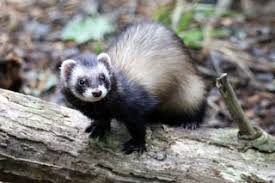
European Polecat
Conditions of detention
European Polecats are highly adaptable and can live in a wide range of environments, including forests, wetlands, farmlands, and semi-urban areas. They prefer areas with dense cover where they can hunt and find shelter. Polecats make their dens in burrows, under tree roots, or in rock crevices, often repurposing dens made by other animals.
Useful Fact: European Polecats are nocturnal and solitary, spending most of their time in their dens during the day and emerging at night to hunt.
Nutrition and diet
European Polecats are obligate carnivores, meaning their diet consists almost entirely of meat. They primarily hunt small mammals like rodents and rabbits but will also eat birds, amphibians, reptiles, and insects. Their opportunistic hunting behavior allows them to adapt their diet to the availability of prey in their environment.
Useful Fact: Polecats have a strong bite and are capable of killing prey larger than themselves, using a precise bite to the neck or skull to immobilize their catch.
Health
In the wild, European Polecats face various health challenges, including parasites, diseases, and injuries from hunting or encounters with predators. Common diseases include rabies and canine distemper, both of which can be fatal. However, their solitary lifestyle helps limit the spread of contagious diseases within populations.
Useful Fact: European Polecats have a lifespan of around 5 to 6 years in the wild, but they can live longer in captivity under controlled conditions.
Grooming and care
As wild animals, European Polecats groom themselves to maintain their thick, water-repellent fur. They use their teeth and claws to remove dirt and parasites. In captivity, polecats benefit from an environment that allows them to maintain their natural grooming behaviors, such as access to clean bedding and the ability to dig.
Useful Fact: The oily nature of a polecat’s fur helps it repel water and stay dry, even when hunting in wet environments.
Education and training
European Polecats are intelligent animals with strong instincts, but they are not typically trained like domesticated ferrets. In captivity, they can be conditioned to accept human handling for veterinary care or breeding purposes, but their wild nature means they are less responsive to training than their domesticated relatives.
Useful Fact: European Polecats rely heavily on their natural instincts for hunting and survival, making them skilled and efficient predators.
Toys and entertainment
In the wild, European Polecats are constantly engaged in hunting and exploring, which provides natural stimulation. In captivity, they require enrichment activities that mimic these natural behaviors, such as digging areas, tunnels, and opportunities to hunt live prey or toys that simulate hunting.
Useful Fact: Enrichment activities that encourage natural behaviors, like digging or foraging, are essential for the mental well-being of captive European Polecats.
Safety
European Polecats are solitary and territorial animals that are generally cautious of humans and other animals. In the wild, they avoid danger by staying hidden and using their keen senses to detect threats. In captivity, ensuring their enclosure is secure and provides plenty of hiding places is crucial for their safety and comfort.
Useful Fact: When threatened, polecats can release a strong, musky odor from their anal glands to deter predators, a trait they share with other mustelids.
Accessories
In captivity, European Polecats need a variety of accessories that replicate their natural environment. This includes secure enclosures with plenty of space to explore, dig, and hide. They require bedding that they can burrow into, as well as items like tunnels, logs, and rocks to simulate their natural habitat.
Useful Fact: Providing a variety of textures and hiding spots in their enclosure helps keep European Polecats engaged and allows them to express natural behaviors.
Socialization
European Polecats are solitary animals that do not seek out the company of other polecats except during the breeding season. In captivity, they are typically housed alone or with a mate. They can become stressed if forced into close quarters with other animals, making careful management of their social environment important.
Useful Fact: Outside of the breeding season, European Polecats are highly territorial and will defend their territory from intruders, including other polecats.
Travel and Transportation
When European Polecats need to be moved, such as for relocation or transfer to a breeding program, they are transported in secure, well-ventilated carriers. The process must be handled with care to minimize stress, as polecats are sensitive to changes in their environment.
Useful Fact: European Polecats are generally nocturnal and may become more active and anxious during travel if moved during daylight hours.
Behavior and psychology
European Polecats are nocturnal, solitary, and territorial animals with a strong instinct for hunting. They rely on stealth and their keen senses to catch prey and avoid predators. Polecats communicate primarily through scent marking and vocalizations, especially during the breeding season when males seek out females.
Useful Fact: European Polecats have a unique behavior of “hissing” or “spitting” when threatened, a warning sign to potential predators or rivals to keep their distance.
Legal aspects
In many countries, the European Polecat is protected by law due to its status as a native wildlife species. Ownership, hunting, or capture of polecats is often regulated, and in some places, it is illegal to keep them as pets. Conservation programs focus on protecting their natural habitat and ensuring sustainable population levels.
Useful Fact: The European Polecat is listed as “Least Concern” on the IUCN Red List, but its conservation status varies by region, with some populations at risk due to habitat loss and human activity.


